Kiniero Mining

Kiniero Mining
The Kiniero Gold Project is located in the prolific gold producing Siguiri Basin in the Republic of Guinea and was awarded to us in January 2020.
The Project is located approximately 600km by road from the capital of Guinea, Conakry, in the Kankan region of Upper Guinea. The Kiniero gold deposits were discovered in the early 1900s and were subsequently explored until 2002 when gold production began under the ownership of Semafo Inc and its Guinean subsidiary Semafo Guineé S.A..
The historical Kiniero gold mine comprised an open pit mining operation which produced a total of 418,000 ounces (oz) of gold (Au) during its 12 year operational history. The mine was placed on care-and-maintenance in early 2014 with the mining and exploration licences revoked in 2014. At the time of the mine closure, the Kiniero mine and associated exploration projects had an estimated mineral resource of 1.5 million ounces gold (measured, indicate and inferred).
On 12 March 2020, Sycamore Mining commenced drilling at the target, with the third drillhole of the campaign (RC20-003) being the discovery hole, returning 11m at 1.05g/t (from 29m) and 20m at 1.01g/t (from 55m).
The discovery was named Sabali South which has a proximal location to the new proposed 3Mtpa plant (~1.5km), easily accessible and topographically gently undulating. Subsequent extensive exploration has confirmed that the Sabali South deposit forms a part of a much larger shear mineralised corridor, termed the Sabali-Mansounia Corridor. The cumulative 6km strike length of the Sabali-Mansounia Corridor has been under-explored, which is currently largely open along strike and at depth. This discovery represents the single largest discovery within the 326km² Kiniero Gold Project since the discovery of the Jean and Gobelé deposit in the 1950s. More importantly, the Sabali-Mansounia Corridor represents one of the largest contiguous zones of mineralisation within the Southern Siguiri Basin. More than 20 years on since the original development of the historic Kiniero Gold Mine, the discovery and evolved understanding of the broader Kiniero Gold District underlines the level of prospectivity, and under-explored targets, within this sector of the Siguiri Basin in Guinea.
Highlighted workstreams over the preceding two years include:
Extensive Drilling and Assaying – all completed by Sycamore Mining. A total of five (5) diamond drillholes for ~1,200m (geotechnical and geology), 259 RC drillholes for ~42,000m (to a 25m grid spacing along strike) and three (3) trenches for 500m have been completed. Drilling is ongoing at the time of this press release. Laboratory assay work has been completed by SGS Bamako, SGS Ouagadougou and Intertek Tarkwa – all accredited and reputable laboratories in West Africa.
Site visits by three independent geological and mining consultancies over the preceding two years have verified the work completed and corroborated the findings and interpretations to date.
Demonstrated Prospectivity: Commencement of a Project-wide BLEG soil sampling campaign on 26 October 2020, which has been completed across Sabali South, and is ongoing through the Mansounia Licenses currently. BLEG results indicate that mineralisation remains evidently open to the south and east of the Sabali South deposit with some highly anomalous zones (>0.5g/t, and in some instances >1.5g/t), in a corridor which is well defined, over 700m in width and only partially drill tested. The BLEG results materially bolster the prospectivity of the mineralised Sabali-Mansounia Corridor, considering the ongoing demonstrated relationship between the BLEG gold-in-soil with the drilling results.
Multiple high-priority ready-to-drill targets at Sabali South (extending into the Mansounia License) are identified, which will complement the increasing resource-base from Sabali South; and Integrating the BLEG results with reprocessed airborne magnetic geophysical data yields a trend of positive magnetic response with the BLEG gold-in-soil geochemical anomalism, which is accentuated where transected by fractures or fracture intersections.
Project-wide airborne geophysical data merged and reprocessed in January 2022 between Mansounia (2004 survey) and Kiniero (2007 survey), providing an integrated magnetic dataset over the entire Kiniero Gold District. Interpreted features provide further support for the structural frameworks within the Sabali-Mansounia mineralised corridor. Structures outlined at district and deposit scale continue to provide strong correlation with soil geochemistry, with the identification of probable intrusives within and around the Sabali South deposit.
The structural resolution of the data is notable, correlating the known geology and structural understanding against the developing BLEG gold-in-soil geochemical fabric.
Four styles of mineralisation have been identified from the completed drilling:
supergene mineralisation developed above mineralised lodes that has consistently developed from surface to 20m-30m depth. These oxide supergene ores have high economic value and occur across the Sabali South deposit;
classic West African greenstone gold stockwork mineralisation; deep connected high-grade lode systems; and intrusives hosting pervasive quartz-carbonate alteration and discrete quartz-sulphide stockworks.
A robust geological model is characterised by a pronounced oxide weathering profile, which is deeply developed (>60m) in the east of the deposit. Beneath the upper oxide layer is a hydrothermally altered sulphide ore unit that is mechanically similar to the overlying oxide, followed by saprock and fresh horizons.
there are primary lithostratigraphic controls on early fluid movement, followed by secondary changes in permeability brought about by hydrothermal alteration, fracturing displaying differing levels of hydraulic brecciation, fluidisation, and quartz-sulphide veining; and continuity of mineralised structures is well understood, with assays and grades reporting to the mineralised intervals modelled as per the Sabali South geological model section on section, corroborating the growing geological understanding and interpretation of the Sabali South deposit.
Drilling has been completed across the “discovery” portion of the deposit on a 25m by 25m grid through 800m of strike and 400m of width since the acquisition by Sycamore Mining, extending into the Mansounia License.
previous wider spaced drilling by Gold Fields and Burey Gold on the Mansounia license-side of the deposit demonstrate the continuous extension of the mineralisation of the Sabali-Mansounia corridor. It remains open on strike to the north (~1km) and to the south (~4km); and results returned from the deeper holes (>150m) at Sabali South have intersected significant grades which have developed along major structures at depths >100m vertically. There remains no evidence of grade attenuation at depth, but instead an increasingly focused ore‐shoot style of mineralisation in these structures that project to depth.
Metallurgy results include 99% recoveries for oxides, 95% for transition and 80% for fresh rocks with the addition of carbon to mimic the CIL processing route. Previous conventional cyanide leaching yielded recoveries of >80% in the oxide. Metallurgical testwork remains ongoing which is being supported by detailed petrological studies.
In addition to the geological program, parallel mining geotechnical, metallurgy and geohydrology drilling studies have been completed or are underway to establish preliminary deposit economics. Results from all these studies will be incorporated into the Kiniero Gold Project PFS, due for completion in June 2022, which will support a maiden public Sabali South Mineral Resource and Mineral Reserve estimate.







